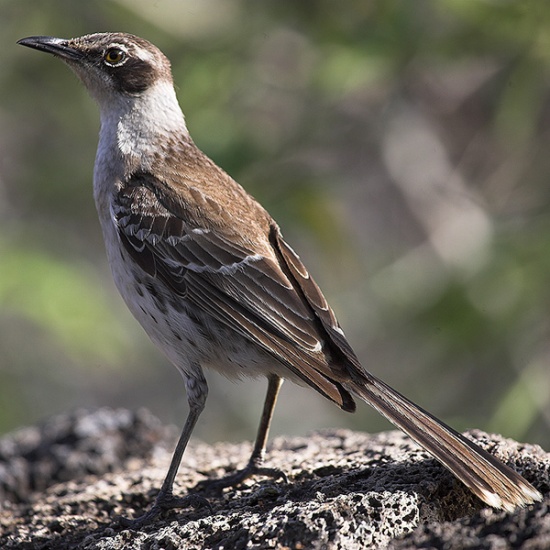- Mimus parvulus
Nesomimus parvulus
Identification
25–26 cm (9¾-10¼ in)
- Slightly de-curved bill
Distribution
Galapagos Islands endemic
Taxonomy
Placed in genus Nesomimus by some authorities.
Subspecies
Six subspecies are recognized[1]:
- M. p. parvulus:
- Main Galapagos Islands except extreme eastern islands
- M. p. barringtoni:
- Barrington (Galapagos Islands)
- M. p. personatus:
- Galapagos Islands (Abingdon, Bindloe, James and Jervis)
- M. p. wenmani:
- Wenman (Galapagos Islands)
- M. p. hulli:
- Culpepper (Galapagos Islands)
- M. p. bauri:
- Tower = Genovesa (Galapagos Islands)
The last subspecies (M. p. bauri) has most of its genome similar to other subspecies of this species, but a few regions indicate past hybridization with introgression of some DNA from San Cristobal Mockingbird[2]. This taxon may be undergoing speciation.
Habitat
They are to be found in a variety of habitats, including low coastal scrub, and light deciduous woodland.
Behaviour
Inquisitive
Diet
Omnivorous. They mostly eat arthropods, including caterpillars also fruit and nectar.
References
- Clements, J. F., T. S. Schulenberg, M. J. Iliff, D. Roberson, T. A. Fredericks, B. L. Sullivan, and C. L. Wood. 2017. The eBird/Clements checklist of birds of the world: v2017, with updates to August 2017. Downloaded from http://www.birds.cornell.edu/clementschecklist/download/
- Birdforum thread containing discussion of Mockingbird taxonomy, with post 11 relevant to this page
- BF Member observations
- Handbook of the Birds of the World Alive (retrieved Dec 2017)
Recommended Citation
- BirdForum Opus contributors. (2025) Galapagos Mockingbird. In: BirdForum, the forum for wild birds and birding. Retrieved 9 May 2025 from https://www.birdforum.net/opus/Galapagos_Mockingbird
External Links
GSearch checked for 2020 platform.1




